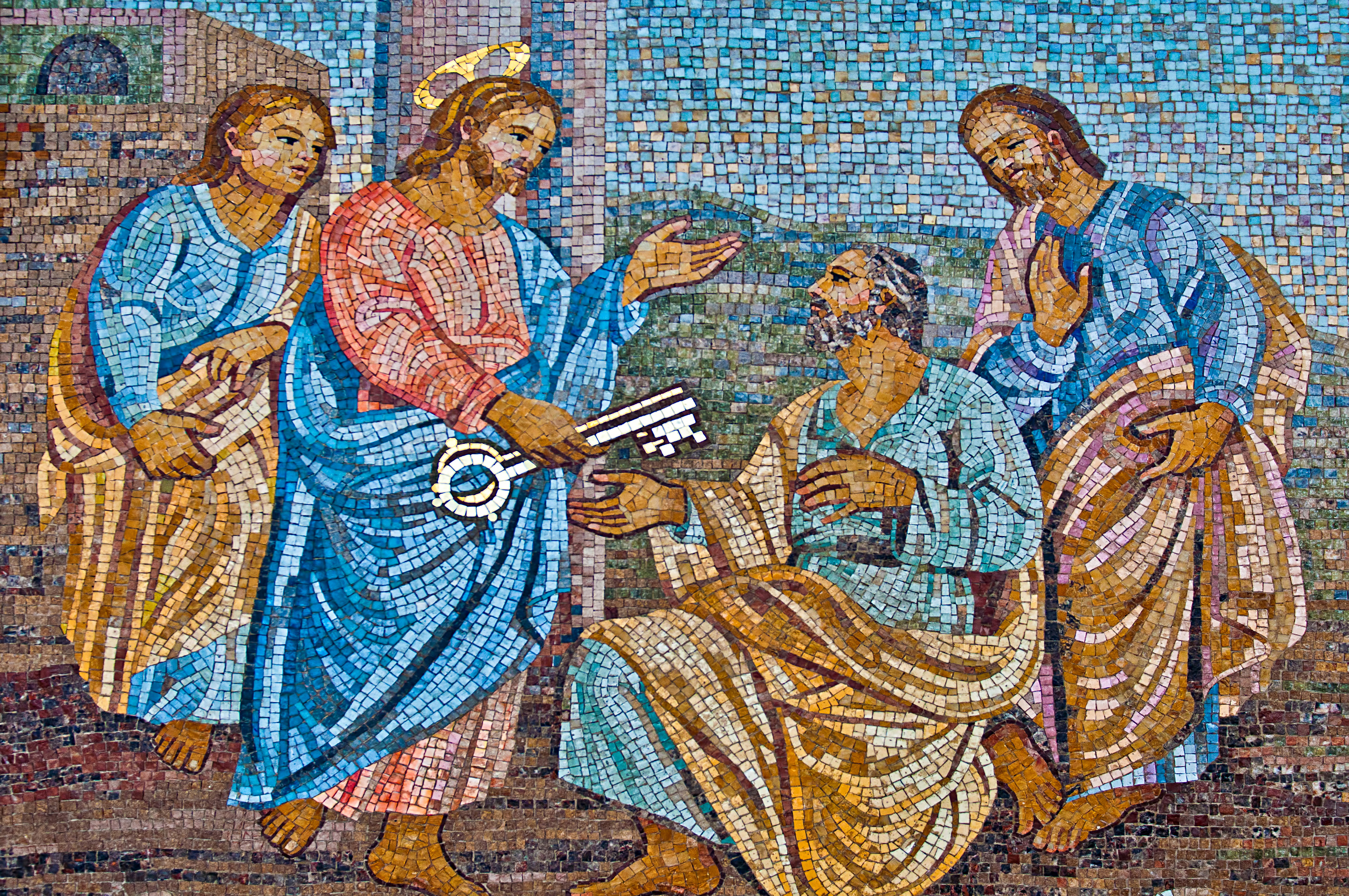How to Weigh Church Teaching

Is everything the Church teaches infallible? How can you tell what is and what isn’t? Just how much weight are we supposed to give to particular teachings?
As Catholics, we trust that the Holy Spirit is guiding the Church, and much of the time, we do not have a pressing need to determine the precise level of authority of a particular statement in a magisterial document. But sometimes we do, particularly in apologetic contexts:
- Liberal dissenters may try to dismiss teachings that are infallible.
- Traditionalist dissenters may underestimate the authority of recent magisterial statements or overestimate the authority of earlier ones.
- Non-Catholics may assume that anything ever said by a pope is supposed to be infallible and on that basis try to generate contradictions or absurdities.
In these situations and others, it’s important to know how to identify the level of authority of a magisterial statement.
Theological notes
For centuries, theologians would assign rankings to different propositions of Catholic belief. These rankings were known as “theological notes.”
The rankings were usually not official. They tended to be applied by individual theologians rather than by the magisterium itself, but they did indicate what weight their authors thought they had.
At the top end were propositions that were de fide definita (“defined as being of the faith”). This referred to dogmas—things that the Church had infallibly defined as revealed by God. Below this was a spectrum of ranks that stretched down to propositio haeretica (“heretical proposition”), which is the rejection of a dogma. In between, theologians distinguished various degrees of certainty or confidence that a particular idea was true or false.
Although the use of unofficial theological notes has fallen off in recent years, it’s striking that the magisterium has begun ranking Catholic teachings in a similar way.
The new profession of faith
In 1998, Pope John Paul II issued a new profession of faith to be used when someone assumes a certain office within the Church (e.g., when someone becomes a bishop or seminary rector).
The first part of this profession of faith is the Nicene Creed, but the second part consists of three concluding paragraphs:
With firm faith, I also believe everything contained in the Word of God, whether written or handed down in Tradition, which the Church, either by a solemn judgment or by the ordinary and universal magisterium, sets forth to be believed as divinely revealed.
I also firmly accept and hold each and everything definitively proposed by the Church regarding teaching on faith and morals.
Moreover, I adhere with religious submission of will and intellect to the teachings which either the Roman pontiff or the College of Bishops enunciate when they exercise their authentic magisterium, even if they do not intend to proclaim these teachings by a definitive act.
These paragraphs refer to teachings with different levels of doctrinal authority, and they were discussed at-length by then-Cardinal Joseph Ratzinger (now Pope Benedict XVI) in a document released by the Congregation for the Doctrine of the Faith.
Dogmas
The truths referred to in the first concluding paragraph of the profession of faith are dogmas. These are truths the magisterium teaches infallibly as being divinely revealed.
They can be taught by the pope, by an ecumenical council, or by the Church’s ordinary and universal magisterium.
According to Cardinal Ratzinger, “These doctrines require the assent of theological faith by all members of the faithful. Thus, whoever obstinately places them in doubt or denies them falls under the censure of heresy” (Doctrinal Commentary on the Concluding Formula of theProfessio Fidei 5).
Other infallible teachings
A step below dogmas are truths referred to in the second concluding paragraph. Cardinal Ratzinger described each of these as sententia definitiva tendenda (Latin, “an opinion to be held definitively”).
Like dogmas, these have been infallibly taught by the magisterium. However, unlike dogmas, the magisterium has not infallibly taught them to be divinely revealed. The magisterium is capable of infallibly teaching certain things that are connected with divine revelation but are not themselves divinely revealed. This allows the Church to protect the truths that are divinely revealed.
For example, a person could challenge a dogma by saying that the pope who taught it was not a valid pope or the council that formulated it was not an ecumenical council.
The Church thus may need to settle whether a particular pope was validly elected or whether a particular council is ecumenical.
Because teachings referred to in the second paragraph are infallible, every believer “is required to give firm and definitive assent to these truths, based on faith in the Holy Spirit's assistance to the Church's magisterium, and on the Catholic doctrine of the infallibility of the magisterium in these matters. Whoever denies these truths would be in a position of rejecting a truth of Catholic doctrine and would therefore no longer be in full communion with the Catholic Church” (Doctrinal Commentary 6).
On the way to being a dogma?
Sometimes the Church infallibly teaches a divinely revealed truth without initially saying that it is divinely revealed.
As an example, Cardinal Ratzinger cited the example of the teaching that priestly ordination is reserved to men alone.
When John Paul II issued his famous motu proprio on the subject (Ordinatio Sacerdotalis), he did not wish “to proceed to a dogmatic definition,” but he “intended to reaffirm that this doctrine is to be held definitively” because “it has been set forth infallibly by the ordinary and universal magisterium.”
But Cardinal Ratzinger was quick to point out that “this does not foreclose the possibility that, in the future, the consciousness of the Church might progress to the point where this teaching could be defined as a doctrine to be believed as divinely revealed.”
The fact that only men can be ordained to the priesthood is thus an infallible doctrine but not a dogma, because the magisterium has not infallibly said that it is a divinely revealed truth.
Whether it is a divinely revealed or a truth in some way connected with divine revelation (but not itself revealed) is presently an open question, according to Cardinal Ratzinger.
Other teachings
The third concluding paragraph deals with other teachings of the magisterium—those that are not dogmas or otherwise infallible.
According to Cardinal Ratzinger, “To this paragraph belong all those teachings—on faith and morals—presented as true or at least as sure, even if they have not been defined with a solemn judgment or proposed as definitive by the ordinary and universal magisterium” (Doctrinal Commentary 10).
These teachings are “an authentic expression of the ordinary magisterium of the Roman pontiff or of the college of bishops and therefore require religious submission of will and intellect. They are set forth in order to arrive at a deeper understanding of revelation, or to recall the conformity of a teaching with the truths of faith, or lastly to warn against ideas incompatible with these truths or against dangerous opinions that can lead to error.
“A proposition contrary to these doctrines can be qualified as erroneous or, in the case of teachings of the prudential order, as rash or dangerous and therefore tuto doceri non potest [Latin, “not able to be safely taught”].”
The Doctrinal Commentary does not give examples of non-infallible teachings, presumably because there are so many. Most statements in magisterial documents fall into this category.
Theological opinions
In the Doctrinal Commentary, Cardinal Ratzinger stated that the third concluding paragraph referred to propositions that the magisterium “presented as true or at least as sure.”
Do magisterial documents ever present teachings in another way?
Actually, they do. Sometimes they propose theological opinions without presenting them as true or sure.
An example comes from Pope Benedict himself, when he considers the nature of the “fire” of purgatory in his encyclical on Christian hope:
Some recent theologians are of the opinion that the fire which both burns and saves is Christ himself, the Judge and Savior. The encounter with him is the decisive act of judgment. Before his gaze all falsehood melts away. This encounter with him, as it burns us, transforms and frees us, allowing us to become truly ourselves (Spe Salvi 47).
He does not mention that, if you read his earlier books, then-Fr. Ratzinger was himself an advocate of this view.
But notice how he presents it here: He says that “some recent theologians” have thought this. He doesn’t say that he does or that the Church does. As a result, he takes an item of theology and proposes it for the reader’s consideration without imposing it as a matter of Church teaching.
He would have done the latter if he had gone on to indicate, in one way or another, that we must accept this view, but he does not. He leaves it as a theological proposal, not a matter of Church doctrine.
Other non-doctrinal statements
In 2011, the Vatican newspaper published a piece that grew out of the Holy See’s dialogue with the traditionalist group known as the Society of St. Pius X.
At one point, the piece observed: “Documents of the magisterium may contain elements that are not exactly doctrinal—as is the case in the documents of the Second Vatican Council—elements whose nature is more or less circumstantial (descriptions of the state of a society, suggestions, exhortations, etc.). Such matters are received with respect and gratitude but do not require an intellectual assent in the strictest sense” (“On Adhesion to the Second Vatican Council,” L’Osservatore Romano, Dec. 1, 2011).
We’ve already seen that magisterial documents may propose theological ideas for the reader’s consideration without making them matters of Catholic doctrine, but what about the kind of pastoral statements the L’Osservatore Romano piece has in mind?
The state of society and the death penalty
An example might be a statement John Paul II made regarding the death penalty. In his encyclical Evangelium Vitae, he stated that society “ought not go to the extreme of executing the offender except in cases of absolute necessity: in other words, when it would not be possible otherwise to defend society.”
He went on to say: “Today however, as a result of steady improvements in the organization of the penal system, such cases are very rare, if not practically nonexistent” (Evangelium Vitae 56).
The second statement could be seen as one of the “descriptions of the state of a society” that is “not exactly doctrinal” and thus as a judgment that should be “received with respect and gratitude” but that does “not require an intellectual assent in the strictest sense.”
This understanding may be reflected in statements made by Cardinal Ratzinger in a 2004 memorandum where he wrote:
“If a Catholic were to be at odds with the Holy Father on the application of capital punishment or on the decision to wage war, he would not for that reason be considered unworthy to present himself to receive Holy Communion. . . .
“There may be a legitimate diversity of opinion even among Catholics about waging war and applying the death penalty” (Worthiness to Receive Holy Communion: General Principles 3).
The spectrum
We’ve seen that several different kinds of statements can be found in magisterial documents:
1.Dogmas
2.Other infallible statements
3.Doctrines that have not been taught infallibly
4.Theological opinions
5.Other non-doctrinal statements.
This leaves us with an important question: How can we know which category to assign a statement to?
This can be tricky, because over the centuries the magisterium has used different methods of signaling the weight of a teaching. Today the matter is mostly discussed by experts, and the experts do not always agree.
But there are some indicators.
Indicators of Infallibility
There is no set form of words that a pope or council must use to make an infallible statement.
The pope teaches infallibly “when as the supreme pastor and teacher of all the Christian faithful, who strengthens his brothers and sisters in the faith, he proclaims by definitive act that a doctrine of faith or morals is to be held” (CIC 749 §1).
The conditions for an ecumenical council are similar (CIC 749 §2).
Although popes and councils can use a variety of wordings to teach infallibly, there are certain words they have tended to use.
Historically, ecumenical councils have used the word anathema when defining a matter.
In recent history, popes have tended to use the verb define when applying their infallibility.
Thus if you find an ecumenical council saying something like, “If anyone says X, let him be anathema,” or if a pope says something like, “We declare and define X,” you are likely looking at an infallible statement. (Though there may be exceptions, as these terms have been used in more than one way in Church history.)
To know whether an infallible statement is a dogma, you need to see whether the one making the definition identifies it as being divinely revealed. If so, it is a dogma.
Non-infallible statements
The default assumption is that statements in a magisterial document will not be infallible.
The Code of Canon Law provides: “No doctrine is understood as defined infallibly unless this is manifestly evident” (can. 749 §3).
If a doctrine is non-infallible, it may have different levels of authority.
According to Cardinal Ratzinger, non-infallible doctrines “require degrees of adherence differentiated according to the mind and the will [the magisterium has] manifested; this is shown especially by the nature of the documents, by the frequent repetition of the same doctrine, or by the tenor of the verbal expression” (Doctrinal Commentary 11).
Here he names three tests that can be used to determine the level of authority attached to a non-infallible teaching.
The three tests
The first is the nature of the document that teaches it. Some documents are more authoritative than others.
A papal encyclical is more authoritative than the weekly general audiences a pope gives, and the dogmatic constitutions of Vatican II are more authoritative than the council’s decrees.
The second test is the frequency with which the magisterium repeats a doctrine.
If it is something mentioned only occasionally, or even rarely (perhaps not even in centuries), it will have a lower level of authority attached to it. But if it is something that the magisterium repeats with great regularity, it is more authoritative.
The third test is the tenor of the words used to express the teaching.
If it is proposed briefly and tentatively, it will have less authority. If it is expounded at length or emphatically, it will have more authority.
Non-doctrinal statements
Identifying statements that fall into the final two categories is done by looking at the words they use.
If a pope identifies a source for a particular idea and he does not indicate that the Church teaches this idea, then it may be something he is proposing for our consideration, or even recommending as worthy of belief, without imposing it as a matter of doctrine.
We saw this earlier with Pope Benedict’s reference to an idea proposed by “some recent theologians” that he discussed without imposing by his own authority.
Similar examples can be found when popes reference ideas from modern biblical scholarship, which often deal with matters of history (how texts were composed and by whom) rather than matters of doctrine.
To think with the Church
We noted that determining the weight the magisterium gives to a particular doctrine can be important in apologetic discussions, when the matter is under dispute.
The skill of being able to identify the nature and weight of a particular magisterial statement is also useful in other contexts.
One reason it’s useful is that it helps us better understand the mind of the Church.
The Church has not chosen to give all its teachings a single level of authority—whether infallibility or any other. Instead, it has chosen to invest different teachings with different levels of authority.
The more we understand those levels, the more we understand the mind of the Church.
And by better understanding the Church’s mind, we better learn sentire cum ecclesia—“to think with the Church.”
Did you enjoy this blog post? Get your copy of Jimmy Akin's new book, Teaching With Authority today. It will help deepen your understanding of what the Church teaches by showing you (maybe for the first time) how and why and where it does.
Recent Posts
-
God Creates Out of Love
God creates, we believe, ex caritate—out of love. If we recall our image of Christianity as a refle …Dec 16th 2025 -
If We Just Love Jesus, Does It Really Matter Which Church We Go To?
When I was considering joining the Catholic Church, I sat down with some of my non-Catholic friends …Dec 12th 2025 -
How Can I Prepare Myself to Receive Holy Communion at Mass More Fruitfully?
Preparation for the celebration of the holy Mass and reception of Holy Communion is an essential el …Dec 8th 2025









